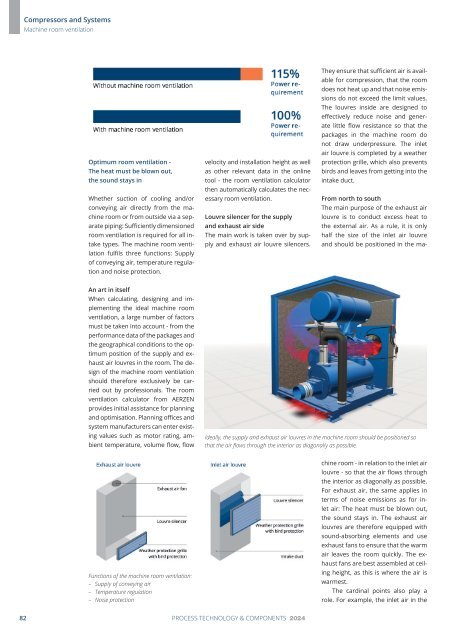PuK - Process Technology & Components 2024
A technical trade magazine with a history of more than 60 years.
A technical trade magazine with a history of more than 60 years.
You also want an ePaper? Increase the reach of your titles
YUMPU automatically turns print PDFs into web optimized ePapers that Google loves.
Compressors and Systems<br />
Machine room ventilation<br />
Optimum room ventilation -<br />
The heat must be blown out,<br />
the sound stays in<br />
Whether suction of cooling and/or<br />
conveying air directly from the machine<br />
room or from outside via a separate<br />
piping: Sufficiently dimensioned<br />
room ventilation is required for all intake<br />
types. The machine room ventilation<br />
fulfils three functions: Supply<br />
of conveying air, temperature regulation<br />
and noise protection.<br />
velocity and installation height as well<br />
as other relevant data in the online<br />
tool - the room ventilation calculator<br />
then automatically calculates the necessary<br />
room ventilation.<br />
Louvre silencer for the supply<br />
and exhaust air side<br />
The main work is taken over by supply<br />
and exhaust air louvre silencers.<br />
They ensure that sufficient air is available<br />
for compression, that the room<br />
does not heat up and that noise emissions<br />
do not exceed the limit values.<br />
The louvres inside are designed to<br />
effectively reduce noise and generate<br />
little flow resistance so that the<br />
packages in the machine room do<br />
not draw underpressure. The inlet<br />
air louvre is completed by a weather<br />
protection grille, which also prevents<br />
birds and leaves from getting into the<br />
intake duct.<br />
From north to south<br />
The main purpose of the exhaust air<br />
louvre is to conduct excess heat to<br />
the external air. As a rule, it is only<br />
half the size of the inlet air louvre<br />
and should be positioned in the ma-<br />
An art in itself<br />
When calculating, designing and implementing<br />
the ideal machine room<br />
ventilation, a large number of factors<br />
must be taken into account - from the<br />
performance data of the packages and<br />
the geographical conditions to the optimum<br />
position of the supply and exhaust<br />
air louvres in the room. The design<br />
of the machine room ventilation<br />
should therefore exclusively be carried<br />
out by professionals. The room<br />
ventilation calculator from AERZEN<br />
provides initial assistance for planning<br />
and optimisation. Planning offices and<br />
system manufacturers can enter existing<br />
values such as motor rating, ambient<br />
temperature, volume flow, flow<br />
Ideally, the supply and exhaust air louvres in the machine room should be positioned so<br />
that the air flows through the interior as diagonally as possible.<br />
Functions of the machine room ventilation:<br />
– Supply of conveying air<br />
– Temperature regulation<br />
– Noise protection<br />
chine room - in relation to the inlet air<br />
louvre - so that the air flows through<br />
the interior as diagonally as possible.<br />
For exhaust air, the same applies in<br />
terms of noise emissions as for inlet<br />
air: The heat must be blown out,<br />
the sound stays in. The exhaust air<br />
louvres are therefore equipped with<br />
sound-absorbing elements and use<br />
exhaust fans to ensure that the warm<br />
air leaves the room quickly. The exhaust<br />
fans are best assembled at ceiling<br />
height, as this is where the air is<br />
warmest.<br />
The cardinal points also play a<br />
role. For example, the inlet air in the<br />
82 PROCESS TECHNOLOGY & COMPONENTS <strong>2024</strong>

















